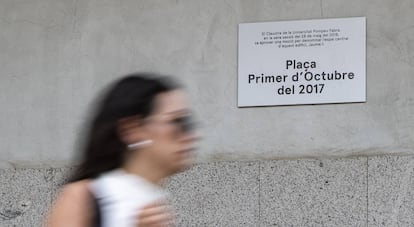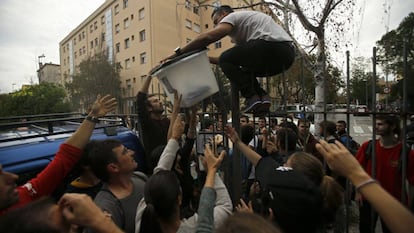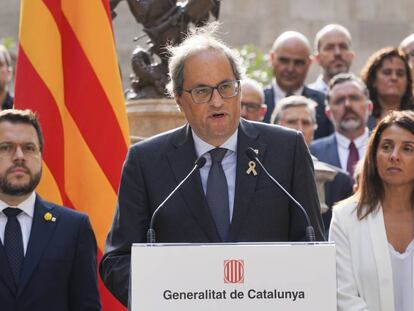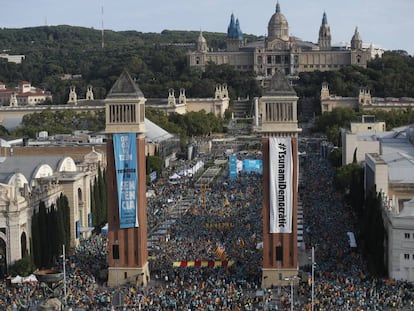Catalan towns rename public spaces after 2017 independence referendum
Streets and squares in more than 120 municipalities have paid tribute to a vote that was declared unconstitutional by the courts


More than 120 municipalities in Catalonia have public spaces named after October 1, 2017, as a tribute to an unauthorized referendum on independence that was held that day.
The Catalan Cartography and Geography Institute (ICGC), which answers to the Catalan regional government, does not have official figures on how many public spaces have been named after the independence referendum, which was declared illegal by the Constitutional Court.
But Miquel Parella, the head of toponymy at ICGC, says that a blog named Cronovies has very precise information. According to this blog, 104 streets have already been renamed or are about to be following council approval.
Nearly 130 public spaces in Catalonia pay tribute to the illegal independence referendum
Parela says that the last time such a sweeping change of place names took place in Catalonia was during Spain’s transition to democracy. “Since the 1980s, there have been intermittent changes, or the introduction of names in new real estate developments. Possibly this is the most notable change in street nomenclature since the Transition.”
The Cronovies blog does not take into account at least 15 municipalities that already, or soon will, have a street named after the referendum, meaning that the total number is higher than 120. And if the names of municipal buildings such as libraries or sport centers are taken into account, there are nearly 130 public spaces in Catalonia that pay tribute to the unauthorized independence referendum.

One of the streets not included in Cronovies is in Sarral, a municipality in Tarragona province that is home to 1,500 residents. When the street was inaugurated in 2018, the then-mayor, Josep Amill of the separatist party Junts per Sarral (Together for Sarral), praised the locals’ attempts to stop the police from confiscating ballot boxes. “The Civil Guard arrived but everyone came out to protect the ballot boxes. There was a big struggle, and when they entered, it was almost because we let them in. They did not find the ballot box and we were able to vote for what we had so yearned for: freedom.”
According to the Catalan regional government, more than 2.2 million people voted in the unauthorized independence referendum. A few weeks later, the Catalan parliament passed a unilateral declaration of independence in another act that was declared illegal by the Constitutional Court.
Tributes to October 1, 2017 are most commonly seen in areas where there was a violent police response to the referendum. In Sant Carles de la Ràpita, in Tarragona province, there is an October 1 square and also a statue dedicated to “the men and women of Sant Carles de la Ràpita who, in the face of repression, defended the right to freedom and to vote.”
Possibly this is the most notable change in the street nomenclature since the Transition
Miquel Parella, head of toponymy at ICGC
In Aiguaviva, a small village in Girona province where riot police tried to confiscate ballot boxes, the city council changed Constitution square to October 1 square in 2018. There is a plaque that reads: “This square receives the name of October 1 as testimony and in recognition of all the people who made the October 1, 2017 referendum possible and who peacefully and courageously defended their right to vote despite the brutal police repression that was seen that day.”
Vilagrasseta, a hamlet of 27 residents in Montoliu de la Segarra, in Lleida province, was the first place in Catalonia to pay tribute to the referendum: it inaugurated a public square on July 29, 2017, two months before the vote even took place.
The Lleida city council has approved a name change to a public square that will make it the second provincial capital in Catalonia to dedicate a public place to the referendum. Barcelona still does not have one, but Pompeu Fabra University has named the central square of its Ciutadella campus after the date of the unauthorized vote.
City councils across Girona province have been the most active about reflecting the referendum in their street nomenclature. In the city of Girona, the former Constitution square has been renamed Plaça de l'U d'octubre del 2017 and a plaque was placed at the bottom of a statue honoring “the dignified behavior of the people and their courage” in the face of the “brutal aggression of the Spanish security forces.” The statue, which dates back to 1991, is of María del Mar Cabeza, a young girl who was born on the same day that the Spanish Constitution was approved in a referendum. On that day, December 6, 1978, 89% of voters who cast their ballots in the province of Girona were in favor of the Spanish Constitution.
English version by Melissa Kitson.









































